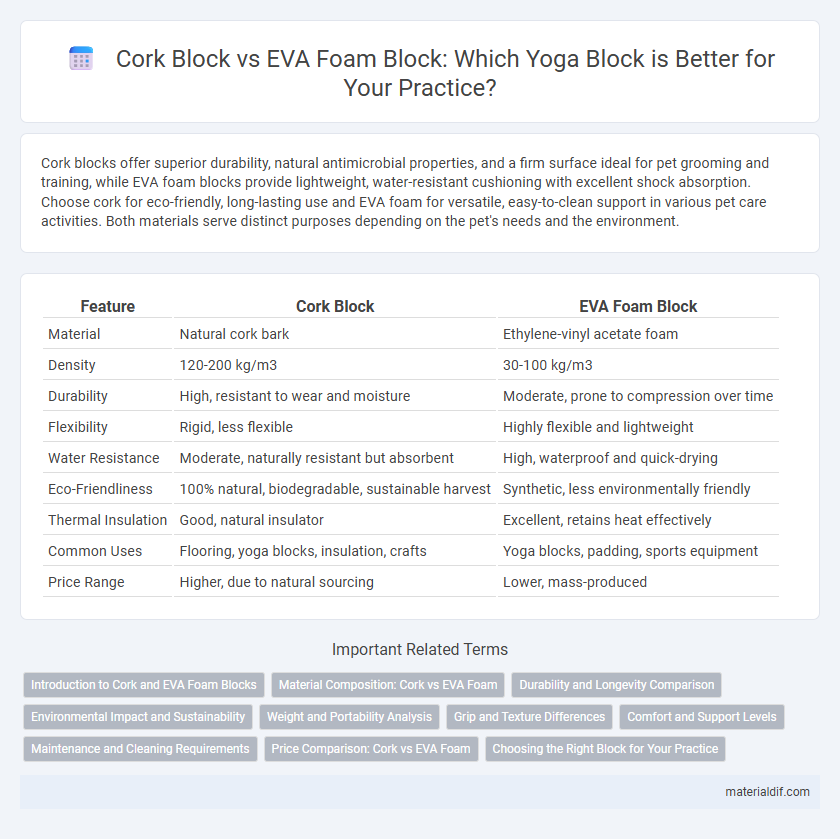Cork blocks offer superior durability, natural antimicrobial properties, and a firm surface ideal for pet grooming and training, while EVA foam blocks provide lightweight, water-resistant cushioning with excellent shock absorption. Choose cork for eco-friendly, long-lasting use and EVA foam for versatile, easy-to-clean support in various pet care activities. Both materials serve distinct purposes depending on the pet's needs and the environment.
Table of Comparison
| Feature | Cork Block | EVA Foam Block |
|---|---|---|
| Material | Natural cork bark | Ethylene-vinyl acetate foam |
| Density | 120-200 kg/m3 | 30-100 kg/m3 |
| Durability | High, resistant to wear and moisture | Moderate, prone to compression over time |
| Flexibility | Rigid, less flexible | Highly flexible and lightweight |
| Water Resistance | Moderate, naturally resistant but absorbent | High, waterproof and quick-drying |
| Eco-Friendliness | 100% natural, biodegradable, sustainable harvest | Synthetic, less environmentally friendly |
| Thermal Insulation | Good, natural insulator | Excellent, retains heat effectively |
| Common Uses | Flooring, yoga blocks, insulation, crafts | Yoga blocks, padding, sports equipment |
| Price Range | Higher, due to natural sourcing | Lower, mass-produced |
Introduction to Cork and EVA Foam Blocks
Cork blocks are natural, renewable materials harvested from the bark of cork oak trees, offering lightweight, compressible, and moisture-resistant properties ideal for insulation and cushioning. EVA foam blocks, made from ethylene-vinyl acetate copolymers, provide flexible, durable, and shock-absorbing characteristics widely used in sports equipment, footwear, and packaging. Both cork and EVA foam serve as versatile blocks in construction and manufacturing, with cork emphasizing sustainability and EVA foam excelling in elasticity and impact resistance.
Material Composition: Cork vs EVA Foam
Cork blocks are made from the bark of cork oak trees, providing a natural, renewable, and biodegradable material with cellular structure that offers excellent cushioning and breathability. EVA foam blocks consist of ethylene-vinyl acetate, a synthetic polymer that delivers high shock absorption, flexibility, and durability but lacks the eco-friendly properties of cork. The material composition of cork ensures hypoallergenic and moisture-resistant benefits, whereas EVA foam emphasizes resilience and lightweight performance in applications.
Durability and Longevity Comparison
Cork blocks offer exceptional durability due to their natural resistance to moisture, mold, and wear, making them ideal for long-term applications. EVA foam blocks provide excellent cushioning and flexibility but tend to compress and degrade faster under heavy use or exposure to harsh environments. When comparing longevity, cork blocks outperform EVA foam blocks by maintaining structural integrity and resilience over extended periods.
Environmental Impact and Sustainability
Cork blocks are highly sustainable due to their renewable harvest from cork oak trees without harming the tree, promoting carbon sequestration and biodegradability. EVA foam blocks, derived from petrochemicals, pose environmental challenges including non-biodegradability and higher carbon emissions during production. Choosing cork blocks supports circular economy practices and reduces ecological footprints compared to EVA foam alternatives.
Weight and Portability Analysis
Cork blocks are significantly lighter than EVA foam blocks, offering enhanced portability for crafts and DIY projects. The natural density of cork (approximately 240 kg/m3) makes it easier to handle and transport compared to EVA foam, which typically has a density ranging from 70 to 150 kg/m3 but varies widely depending on firmness. Despite EVA foam's buoyancy and cushioning benefits, cork's lightweight properties and rigidity provide a more stable and portable option for applications requiring ease of movement.
Grip and Texture Differences
Cork blocks offer a natural, firm grip with a slightly textured surface that enhances stability during yoga practice. EVA foam blocks provide a softer, more cushioned texture with a grippier, non-slip surface ideal for sweat-prone users. Choosing between cork and EVA foam blocks depends on desired firmness and tactile feedback for optimal support.
Comfort and Support Levels
Cork blocks offer firm, consistent support that molds slightly to body contours, providing stable cushioning ideal for yoga and rehabilitation exercises. EVA foam blocks deliver softer comfort with higher shock absorption, making them suitable for beginners or those seeking cushioning during extended sessions. Choosing between cork and EVA foam blocks depends on the desired balance of durability, grip, and personalized support in fitness routines.
Maintenance and Cleaning Requirements
Cork blocks require minimal maintenance, needing only occasional wiping with a damp cloth to prevent mold and mildew buildup. EVA foam blocks are highly resistant to water and stains, allowing for easy cleaning with soap and water without deterioration. Cork's natural breathability demands more careful drying to avoid moisture retention, whereas EVA foam's closed-cell structure ensures quick drying and longevity.
Price Comparison: Cork vs EVA Foam
Cork blocks generally have a higher price per cubic foot compared to EVA foam blocks due to their natural, sustainable sourcing and durability. EVA foam blocks are more cost-effective and widely available, often used as a cheaper alternative in applications requiring lightweight and impact-absorbing materials. The price difference is influenced by factors such as material density, manufacturing processes, and eco-friendliness, making cork a premium choice despite its higher cost.
Choosing the Right Block for Your Practice
Cork blocks offer natural sustainability, excellent grip, and moderate firmness, making them ideal for balancing support and comfort in yoga and pilates practices. EVA foam blocks provide lightweight durability, high-density cushioning, and affordable flexibility, suitable for practitioners needing extra padding or extended use in dynamic exercises. Selecting between Cork Block and EVA Foam Block depends on your preference for eco-friendly materials versus lightweight portability and cushioning needs during your routine.
Cork Block vs EVA Foam Block Infographic

 materialdif.com
materialdif.com